Are you tired of feeling like you're playing project management roulette when choosing between Scrum and Waterfall?
You're not alone.
Many product managers feel overwhelmed and fearful of making the wrong choice. Stakeholders demand timelines, teams await direction, and the pressure mounts. The fear of project failure and its potential impact on your reputation and career progression looms large.
Without a clear decision, projects stall, tasks pile up, and priorities blur. Team disengagement sets in, stakeholder frustration grows, and your stress levels skyrocket.
But it doesn't have to be this way and that’s why we’re here!
In this post, we'll cover:
- The dilemma of choosing between Scrum and Waterfall
- What is Scrum
- What is Waterfall
- What’s the difference between Scrum and Waterfall
- How Motion supports your project management needs
Our goal is to help you understand many of the methodologies available, clearly understand their differences, and decide which one is best for you!
Maximize your team's output with Motion
Sign up now to get started
The dilemma of choosing between Scrum and Waterfall
Modern projects are complex beasts. They come with varying requirements, stakeholder expectations, and market pressures.
Teams often find themselves balancing the need for quick decisions against careful planning. It's not always easy to get right.
Let's bust a common myth: there's no "one size fits all" in project management.
You might hear people claim "Scrum is always better because it's agile" or "Waterfall is too old-school."
These oversimplified views miss the point—each project brings its own unique challenges and needs.
Picking the right method matters more than you might think.
It affects how happy your team is, how much they get done, and whether stakeholders feel good about the results.
When your method matches your project goals and what your team can handle, you're setting yourself up for success.
Why choosing the right methodology matters
Taking on a specific project management method requires effort, but the payoff is worth it. Here's what you get:
- Better productivity: Clear plans and processes help teams focus on what matters most. Everyone knows who's doing what and when, letting work flow faster.
- Smarter resource use: When budgets and teams are tight (and when aren't they?), good project management helps you use what you have wisely. The right people work on the right tasks at the right time.
- Lower risks: Every project faces potential problems - scope creep, resource issues, unexpected roadblocks. A solid method helps you spot these early and deal with them before they become big headaches.
- Constant improvement: By tracking what works and what doesn't, teams get better over time. They learn from each project, refine their approach, and stay competitive in a fast-moving market.
What is Scrum?
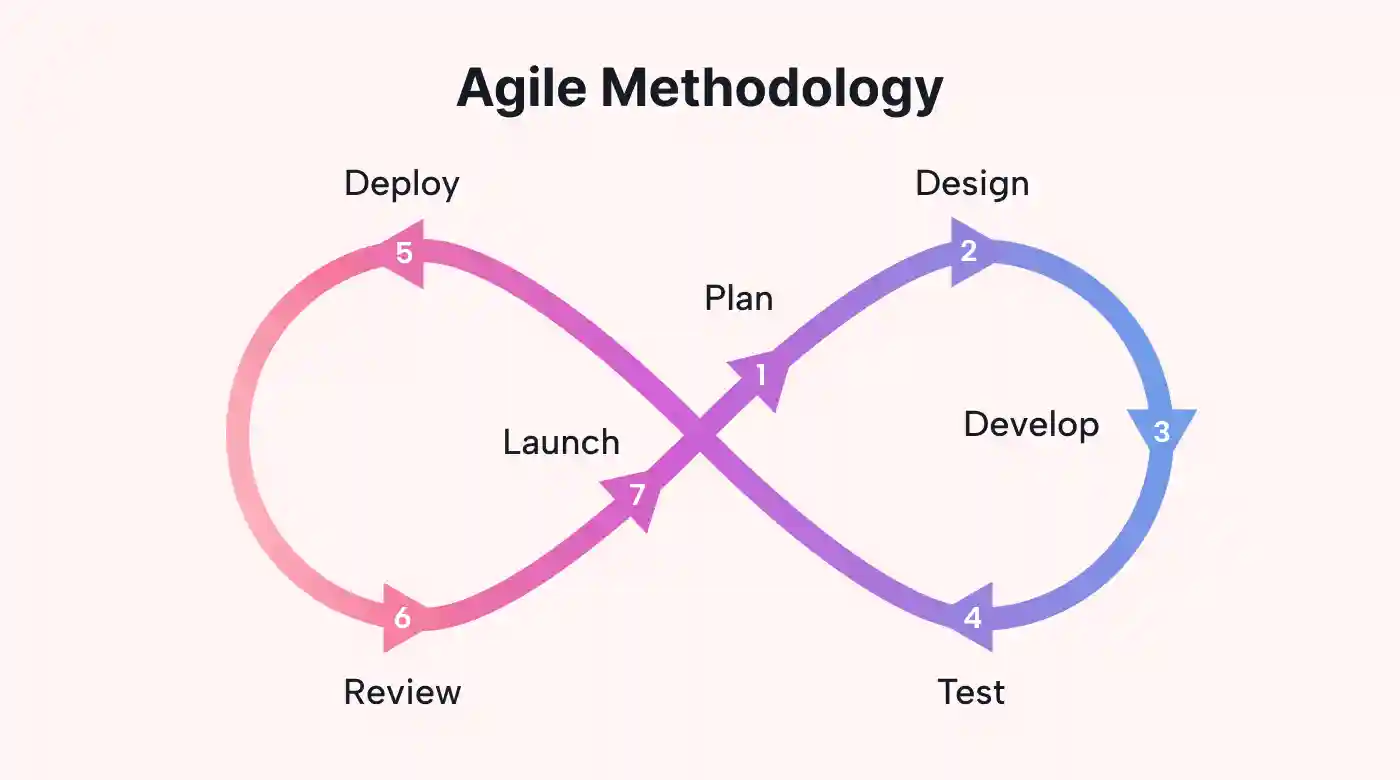
Scrum is an Agile framework for managing complex projects, developed by Ken Schwaber and Jeff Sutherland in the early 1990s.
It's based on empiricism (decisions based on observation, experience, and experimentation) and iterative development (work divided into short cycles called sprints).
Scrum’s emphasis is on flexibility and adaptation—responding to change over following a fixed plan.
Scrum roles
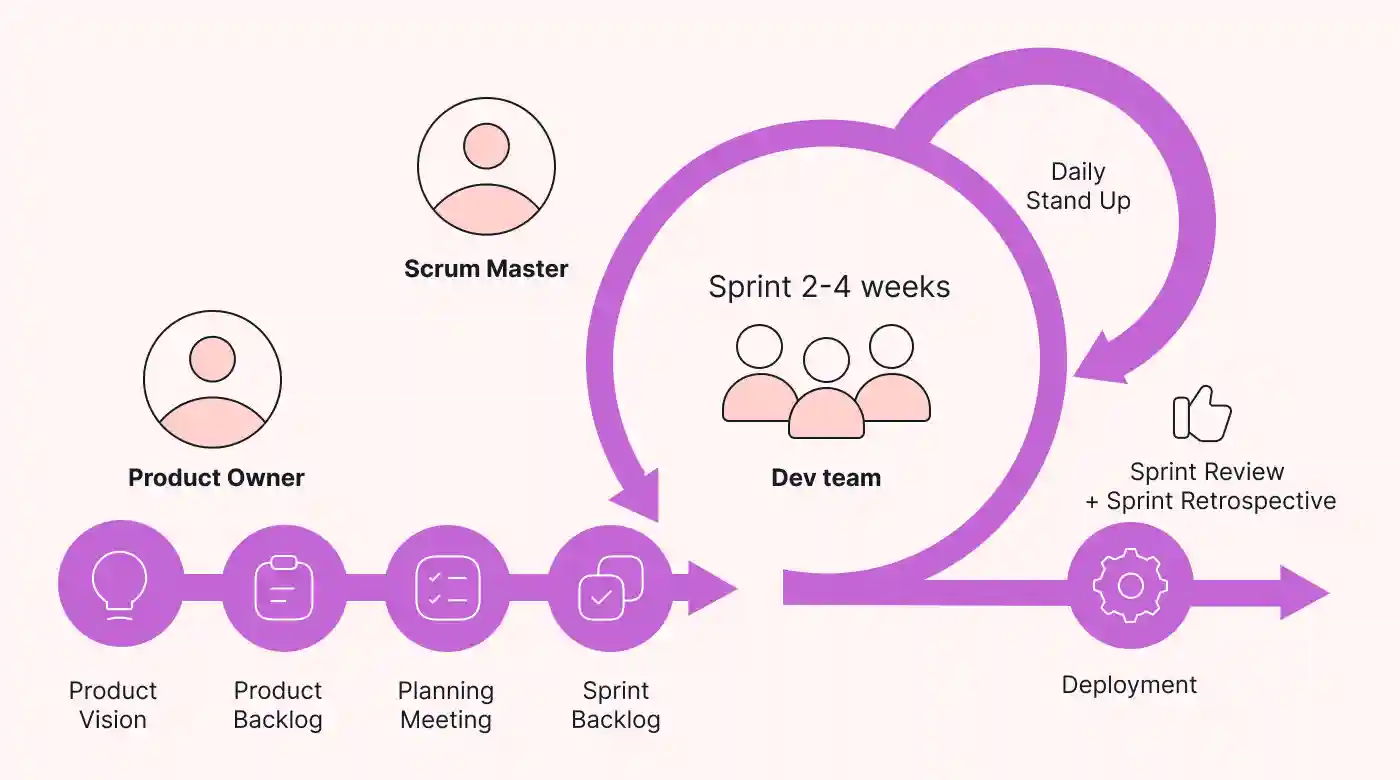
Unlike other project management approaches, Scrum has set roles outside of everyone’s functionary roles. For example, your functional role might be project manager, but you might also be the Scrum Master.
- Scrum Master: Facilitates the process, removes impediments, and coaches the team.
- Product Owner: Represents stakeholders and prioritizes the product backlog.
- Development Team: A cross-functional group that delivers increments of value.
Scrum artifacts
Scrum uses three key artifacts that work together to keep your project organized and transparent.
Let's look at how each one helps your team stay focused and deliver value.
Product backlog
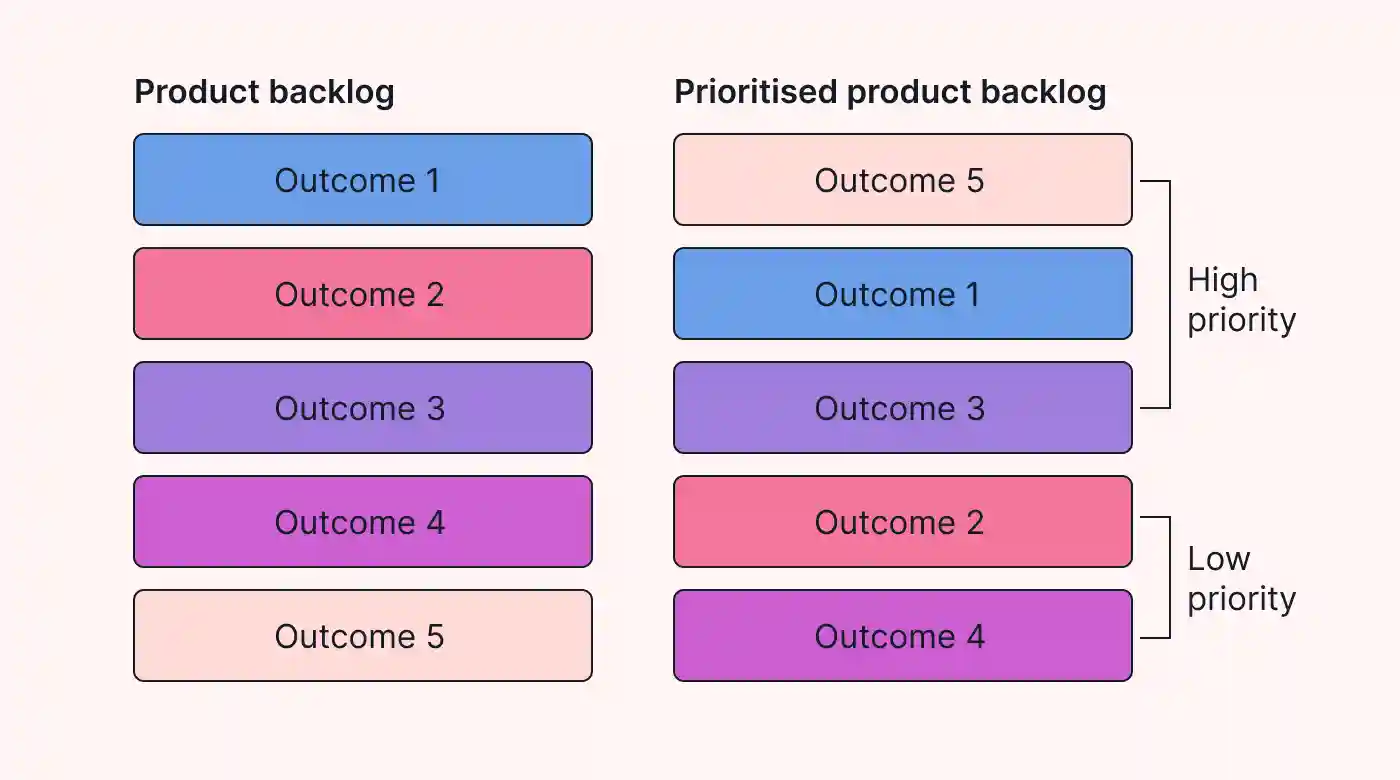
Think of the product backlog as the grand to-do list for your project or product.
It's a dynamic collection of all the features, improvements, and fixes that are defined in the product roadmap and need attention.
Owned by the product owner, this list prioritizes tasks based on their value and importance to users and customers.
Sprint backlog
The sprint backlog is like a focused snapshot of the product backlog, featuring a carefully chosen subset of items to be completed in the next sprint.
It's crafted during sprint planning, a crucial session where the entire team lays out the game plan for their iterative approach to delivering a finished product or service.
This sprint backlog defines the specific tasks to be tackled during the sprint, all geared towards supporting the sprint goal.
Increment
Think of the increment as your sprint's finished work—it's the actual, working piece of your product that meets your team's quality standards.
It represents real progress, showing exactly what you've completed during the sprint.
Each increment builds on previous work, creating a growing product that delivers concrete value to your users and stakeholders.
These three artifacts work hand in hand to keep your project on track.
Your product backlog holds the big picture, your sprint backlog focuses the team on immediate priorities, and your increment demonstrates the real progress you're making sprint after sprint.
Pro tip: The magic happens when these artifacts work together. Your product backlog keeps you dreaming big, your sprint backlog keeps you focused, and your increment shows you're making real progress. It's like having a GPS, a daily planner, and a progress tracker all working in perfect harmony.
Scrum ceremonies
In the Scrum methodology, ongoing ceremonies (events) drive project adaptability and frequent delivery.
Sprint planning kicks off each sprint, followed by the daily stand-up meetings, aptly called daily Scrums, for quick progress updates.
The sprint review showcases accomplishments, and the sprint retrospective allows reflective and continuous improvement.
Backlog refinement fine-tunes the to-do list.
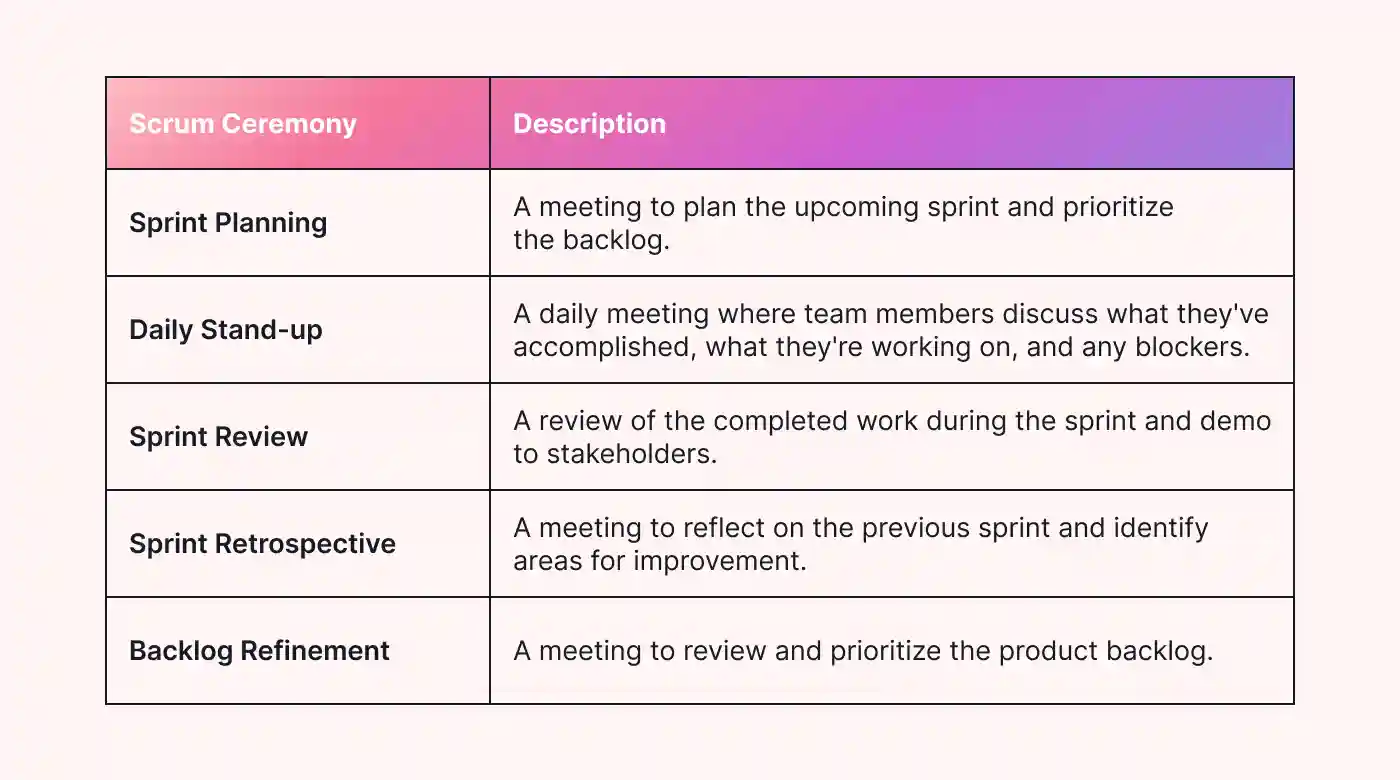
At each stage of the process, customer feedback is integrated into these ceremonies, whether through direct review meetings with the client or from user stories and feature requests.
Customer feedback drives Scrum's incremental approach to continuous improvement.
What we like and dislike about Scrum
Because of its prescriptive nature, Scrum is easy to implement. But it has its pros and cons.
What we like about Scrum
- Scrum fosters teamwork by encouraging regular communication and collective problem-solving
- The framework's regular check-ins (such as daily standups and sprint reviews) ensure clarity and accountability
- Scrum's focus on delivering increments of work in short sprints allows teams to provide value quickly
- Scrum promotes feedback loops from both customers and team members, which helps improve the product and process over time
What we dislike about Scrum
- Scrum requires teams to be self-organized, with everyone contributing equally, which can be challenging for some teams
- Teams with a more traditional, sequential process may struggle to adapt to Scrum's flexible, iterative approach
- Without effective facilitation, the numerous meetings in Scrum (like daily standups, sprint reviews, and retrospectives) can become time-consuming and unproductive
- Scrum is an all-encompassing methodology with specific roles, meetings, and backlog management, which can be overwhelming for teams trying to ease into Agile practices
When to use Scrum
Scrum really shines when your project requirements might shift and change along the way.
Maybe you're building a new product and need to adapt based on user feedback, or working in a fast-moving market where priorities can change quickly.
The flexibility built into Scrum helps teams adjust without derailing the whole project.
This method works particularly well when you need to deliver value quickly and regularly.
Instead of waiting months to see results, Scrum breaks work into short sprints, letting you show progress every few weeks.
This keeps stakeholders engaged and helps catch any issues early.
Teams that already understand agile practices and know how to organize themselves will thrive with Scrum.
They'll need to make quick decisions, manage their own work, and collaborate closely.
The self-organizing nature of Scrum means team members step up to solve problems and make improvements without waiting for top-down direction.
Scrum especially fits projects focused on innovation and experimentation.
The regular feedback loops and sprint structure create natural opportunities to try new approaches, learn from them, and adjust course.
Whether you're developing new software features or launching a new service, Scrum gives you the framework to experiment safely and learn quickly.
What is the difference between Scrum and Agile?
Many people actually confuse Scrum and Agile.
In fact, another way we could have posed this section is with the question, “Is Scrum, Agile? Or is Agile, Scrum?”
Agile is a broad philosophy or mindset that emphasizes flexibility, collaboration, and delivering value in incremental, iterative cycles. It is a set of guiding principles outlined in the Agile Manifesto.
Scrum is a specific framework within the Agile methodology.
It provides a structured approach to implementing Agile principles through defined roles, events, and artifacts.
Scrum encourages teams to deliver their work in short, focused iterations called Sprints, which typically last 1-4 weeks.
So, while Scrum is an Agile framework, Agile encompasses a wider range of frameworks and practices (such as Kanban, XP, and others). If you're looking to adopt Agile practices, Scrum is a great way to implement it in your team.
What is Waterfall?
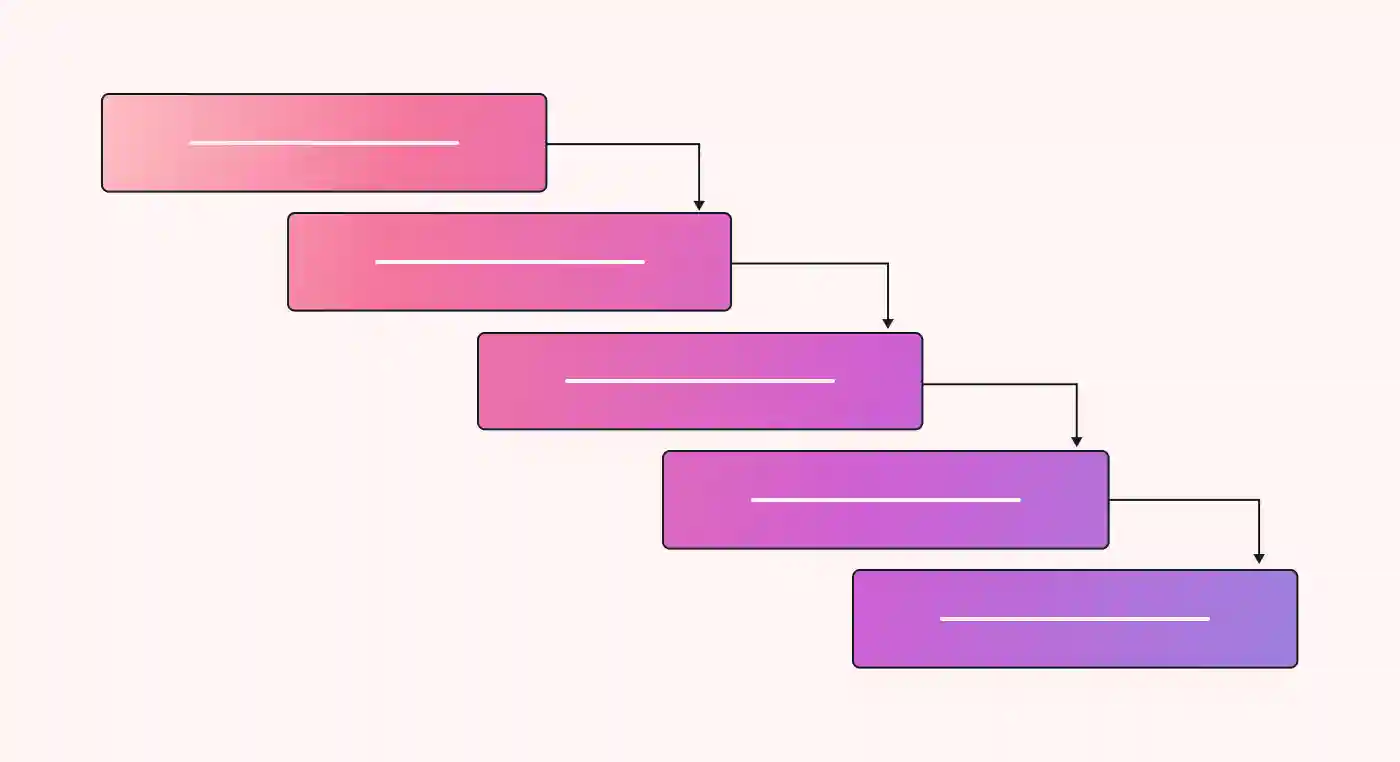
Waterfall is a linear, sequential approach to project management that originated in manufacturing and construction industries.
Introduced by Winston W. Royce in 1970, it emphasizes upfront planning and documentation.
Waterfall models follow six linear steps: requirement gathering, design, implementation, testing, deployment, and maintenance.
These steps must be completed in sequential order.
The Waterfall methodology is big on upfront planning, which works well for projects with clear goals.
Once a step is done, going back is a bit tricky as it encourages the team to start over completely. So, if you need to change something, it can be a massive challenge.
Waterfall project management is a sturdy approach for straightforward projects, but it can be risky if your project needs some flexibility.
Phases of Waterfall methodology
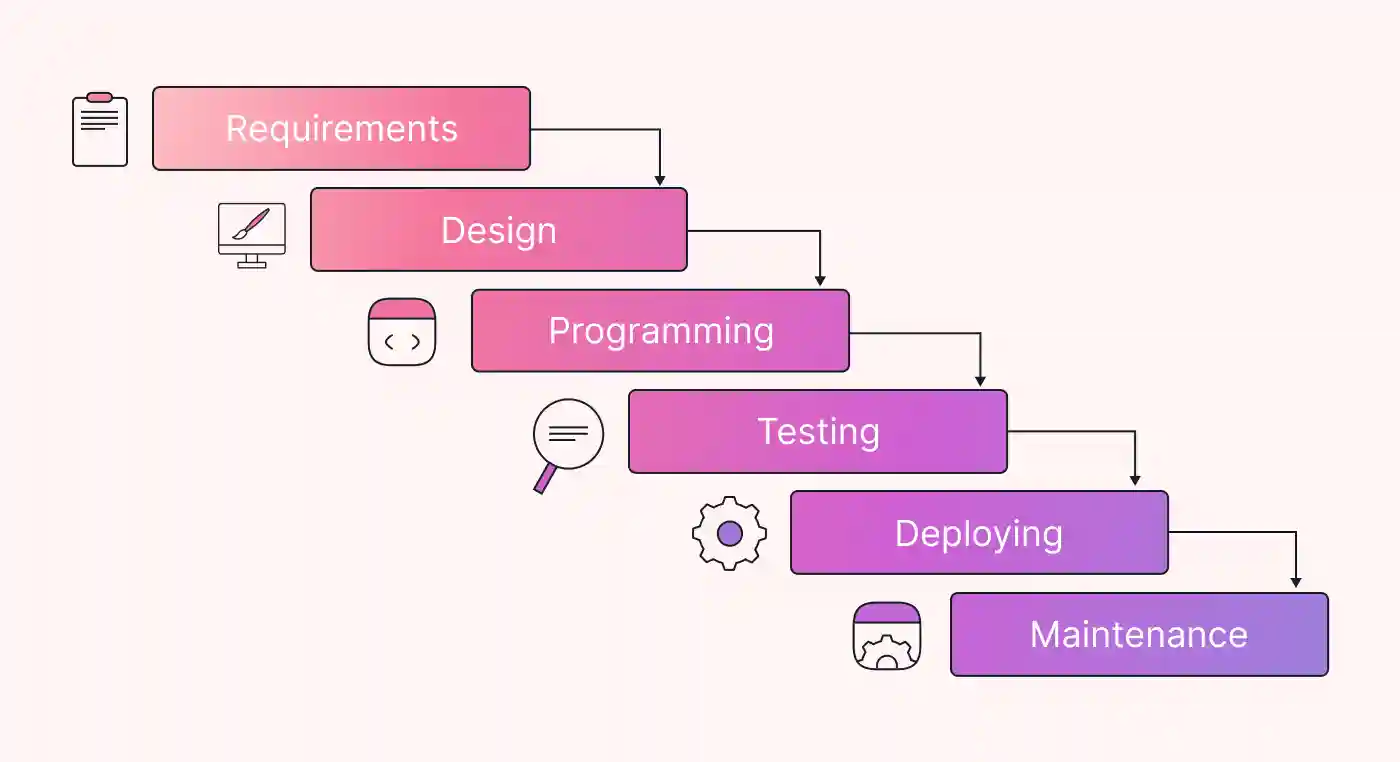
So, how do the six phases play out in the Waterfall approach? Well, they cascade like (you guessed it) a waterfall.
After an initial planning phase, the phases are as follows:
Requirements gathering
Your team kicks off the project by sitting down with stakeholders to understand exactly what they need.
Think of it like creating a detailed blueprint for a house—you map out every room, window, and doorway before picking up any tools.
You'll create detailed documentation that serves as your project's foundation.
Design
Now it's time to plan how you'll build everything. Your team transforms those requirements into detailed technical specs and system designs.
They create the architecture (the big picture view) and design documents (the detailed plans) that will guide your developers through the build.
Implementation
This is where your developers jump in and start building. With clear designs in hand, they write code that matches your specifications.
Think of this as following your blueprint to construct the actual house—every line of code adds another brick to your foundation.
Verification
Time for quality control. Your team runs different types of tests to make sure everything works perfectly:
- They test individual components
- They check how all the pieces work together
- They get users to try it out and confirm it meets their needs
Maintenance
Your product is live! But the work isn't over. Your team keeps things running smoothly by:
- Fixing any bugs that pop up
- Making small improvements
- Keeping the system healthy and stable
Waterfall works like a real waterfall (hence the name)—each phase must finish before the next one starts.
You need to sign off on your requirements before design begins, complete your design before coding starts, and so on.
This approach helps keep everything organized, but it means you need to plan carefully from the start.
What are the three principles of the Waterfall methodology?
The three principles of the Waterfall methodology include:
1.) Limited stakeholder involvement
Think of Waterfall like building a house—you spend lots of time with the homeowner at the start, getting every detail right in the blueprints.
Once construction begins, you don't want them changing their mind about where the kitchen should go. Waterfall works the same way.
Your stakeholders are deeply involved in the early planning stages, but then step back to let the team execute according to plan.
They're not cut off completely—they'll still get updates and can weigh in on critical decisions, but the focus shifts to letting the team work without constant changes to the plan.
2.) Strict and structured approach
Waterfall moves forward in clear, defined steps.
Each phase needs to wrap up before the next one starts—like making sure your foundation is solid before building the walls.
While you can go back if you spot a major issue, it's like realizing you need to adjust the foundation after building the second floor.
Possible, but costly and time-consuming.
The goal is to plan thoroughly enough at the start to avoid these situations.
3.) Detailed documentation
Documentation is your project's memory.
In Waterfall, you create detailed records throughout the entire process, but it's especially crucial at the beginning.
Think of it as writing down every single detail about how that house should look and function before breaking ground.
As the project moves forward, you keep documenting progress, decisions, and any changes.
This way, everyone can look back and understand what was done and why, making it easier to handle any issues that pop up later.
What we like and dislike about Waterfall
What we like about Waterfall
- Unlike Scrum, Waterfall provides a comprehensive approach to training, documentation, user acceptance testing, deployment, and ongoing maintenance, ensuring that each step is fully addressed
- Waterfall is ideal for projects with fixed, well-understood requirements, such as those in construction or manufacturing
- The clear, step-by-step nature of Waterfall makes it easy to understand and manage, particularly for straightforward, predictable tasks
- Waterfall places significant importance on documentation throughout every project phase, ensuring that there’s a clear record of requirements, design, and testing
- The linear, step-by-step approach offers a predictable workflow that can be replicated across complex projects
What we dislike about Waterfall
- Waterfall doesn’t easily accommodate changes once the project is in motion, making it difficult to adapt to new requirements or challenges
- If the initial requirements are unclear or change mid-project, there’s a high risk of customer dissatisfaction, as Waterfall is less flexible in accommodating shifts
- The development phase can be long, with deliverables often not coming until later in the process, which can delay customer feedback
- Testing and user feedback are typically only integrated at the later stages of Waterfall, meaning issues may not be caught until after significant development has occurred
- Since feedback is collected late in the process, there’s a risk that the final product may not align with customer expectations or initial goals after a lengthy production phase
When to use Waterfall
Waterfall isn't always the perfect fit, but for certain projects, it's exactly what you need.
This method works best when your requirements are clear and stable from the start. Your stakeholders have a solid vision, requirements won't change much, and everyone agrees on the end goal.
This might be a new payroll system with well-defined federal requirements, or a manufacturing process that follows specific industry standards.
If you work in healthcare, finance, or government, you'll likely need to document every decision and change for compliance.
Waterfall's structured approach creates a clear paper trail.
Each phase produces detailed documentation that auditors and regulators need to see, making it easier to prove you're following all the rules.
When you're working with a new team or outsourcing work, Waterfall provides the structure everyone needs.
The detailed documentation and clear phases help keep everyone aligned, even if they're not familiar with your company's usual way of working.
It's like having a detailed roadmap that keeps everyone heading in the right direction.
Sometimes you need to make the most of limited time, money, or people. Waterfall's structured approach helps here too.
By planning everything upfront, you can better predict resource needs and avoid costly surprises. Teams can focus on executing the plan rather than constantly adjusting to changes.
How are Gantt Charts connected to Waterfall?
A Gantt chart is a visual project management tool that displays tasks over a timeline, illustrating project schedules and progress.
It helps teams track progress, manage deadlines, and allocate resources effectively by providing a clear overview of a project's timeline.
By offering a bird's eye view of tasks and their durations, Gantt charts facilitate better planning and coordination in complex projects.
Because the Waterfall Methodology centers around a visual workflow, project managers have turned to Gantt charts to showcase their team’s progress.
With Motion, project managers utilizing the Waterfall Methodology can easily create and customize Gantt charts.

What is the difference between Scrum and Waterfall?
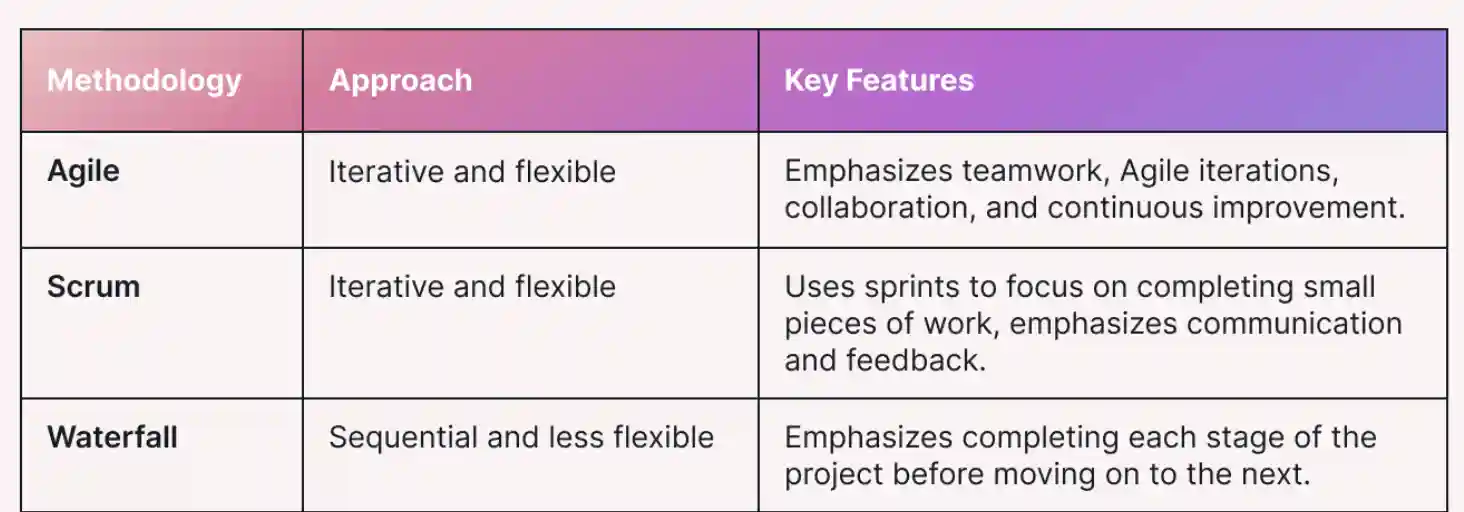
Ultimately, the primary difference between Scrum and Waterfall ultimately comes down to flexibility.
Because Waterfall follows detailed stages, and its creators are adamant about always following the stages in sequential order, that leaves very little room for error. And when errors do occur, the entire team is required to start back up at phase one.
Waterfall can be a great solution, though, for small projects that have detailed requirements and are unlikely to change.
Before determining which process you should use, we suggest asking yourself these questions:
- What is the deliverable of this project, and how does it need to be delivered?
- How much do you need to know about the design before you start? Do you need a dedicated design phase?
- How integrated and compartmentalized are the segments of the deliverable? Do they need to be produced after other features? What are their dependencies?
- How much change do you expect during the project lifecycle (market and product)?
- What kind of team do you have (cross-functional vs. specialized)? And what PM approach are they familiar/comfortable with?
How Motion supports your Scrum and Waterfall needs
Motion is an AI-powered project management solution that integrates with you and your team's calendar and automatically adds tasks in sequential order based on their priority levels.
It also has the ability to reschedule your day with the help of AI whenever something comes up or is pushed back.
As far as deeper project management features that are needed when utilizing specific methodologies, we love Motion’s ability to create tasks with dependencies, track time spent on projects, showcase the impact of changing deadlines, showcase projects via Gantt and Kanban views, and send alerts when team members are over capacity.
Motion offers unique features that set it apart including:
Task scheduling
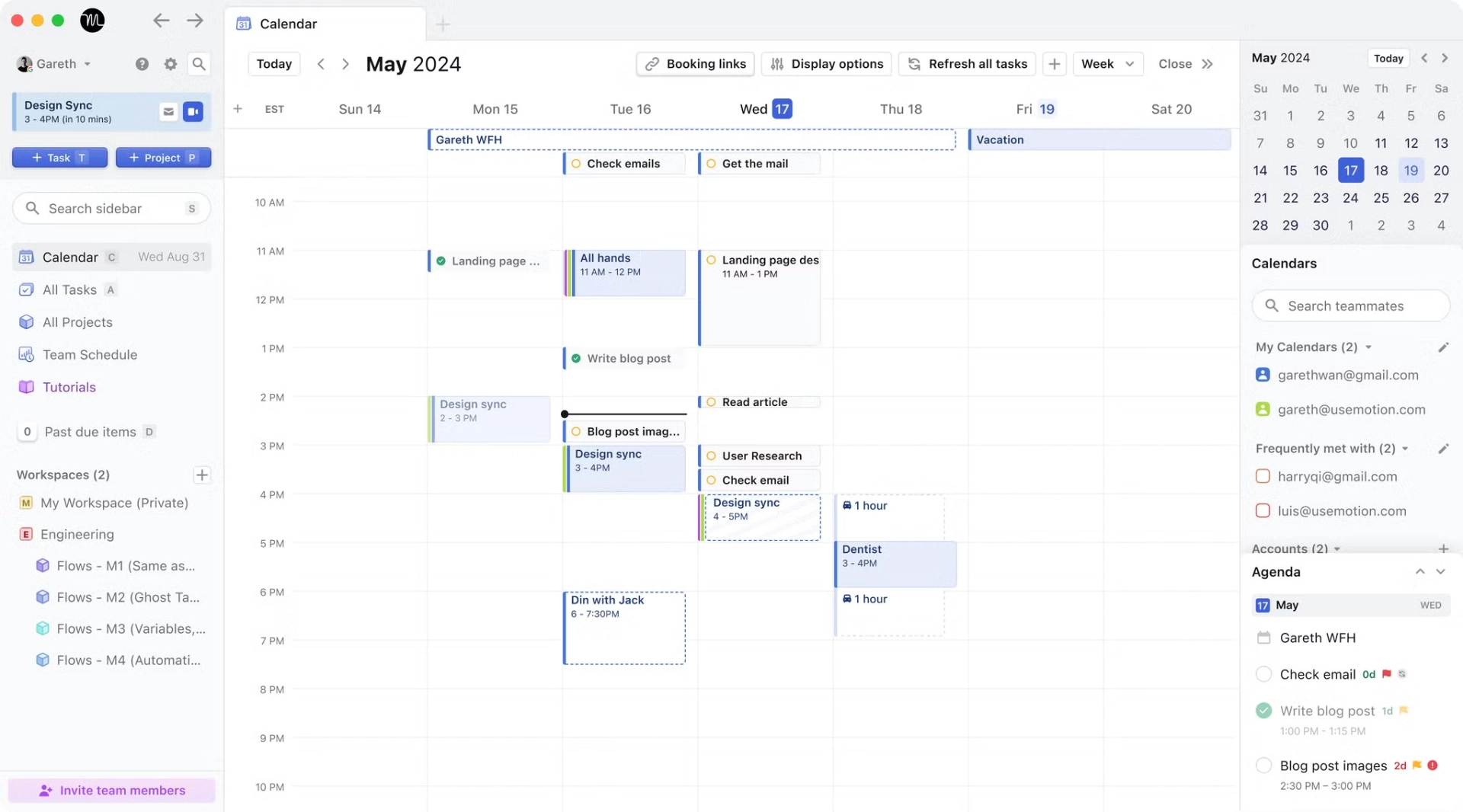
With Motion’s auto-scheduling, users can bulk-add tasks to their to-do lists with attributes like priority level, duration, due date, start date, and more.
From there, Motion will automatically add the task to their calendar between meetings, appointments, and personal commitments at a time that works best for them. This is a perfect feature for sprint planning.
Project management
Motion has really expanded its product to meet the deep project management needs of larger organizations.
With Motion, you can create workspaces and projects with individual tasks, attach documents, create labels, take detailed notes, add comments, and more.

Ability to add elaborate notes and attachments
Because many project management methodologies require detailed documentation throughout the whole process, you need a tool that you can trust to house all of your most important updates.
With Motion, users can upload and organize files directly within Motion, whether it’s in tasks, projects, or project workflow templates.
Custom views
Motion offers multiple ways to view tasks—Gantt, Kanban, list, and the newly released agenda view.
Now, agenda view is a chef's kiss.
While Motion's calendar view lets you see everything in a day, all those tasks and events can get overwhelming, especially if you're not used to that level of scheduling.
Motion recognized the need for something simpler—a view that lets you zero in on what matters without the distraction of a packed calendar.
These features are PERFECT for creating custom views for your stakeholders and production team members.
There’s also a pivot table that helps you better navigate tasks across projects. For Excel users, this concept will feel familiar—you can group tasks by any field in multiple nested layers.
Team collaboration and prioritization
Just as Motion is able to auto-schedule tasks for individuals, it does the same for teams.
With Motion, project managers can assign tasks to individuals with details like priority level, duration, due date, start date, and more, and the tool will automatically schedule the task for a time that works best for that person.
Motion can alert project managers about blockers, team members who are overcapacity, and dependencies. It also creates detailed daily agenda views for each team member and the team as a whole to access at any given time.
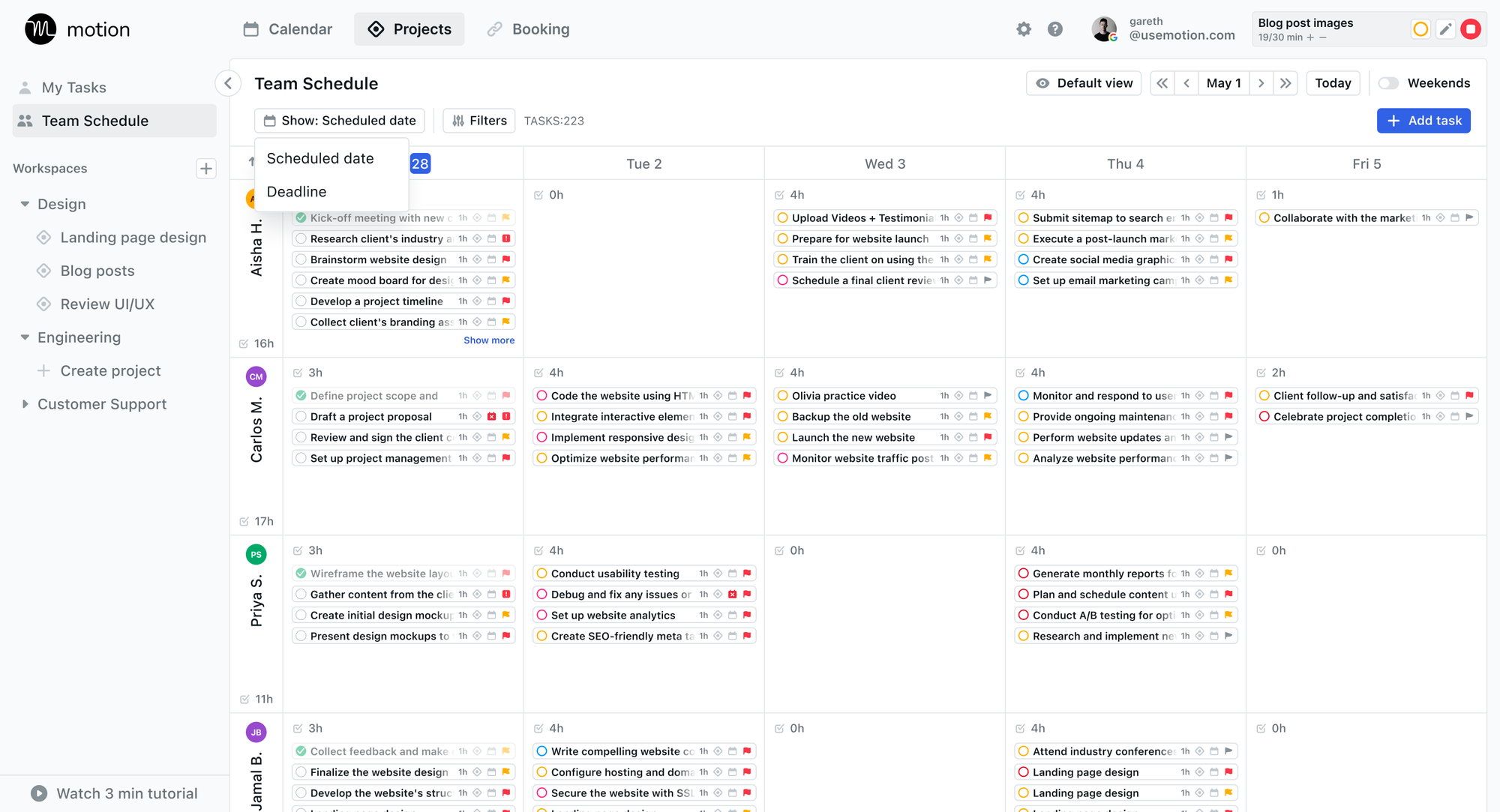
Try Motion today
Tools like Motion are at the forefront of the AI productivity revolution, offering a range of AI-powered features that streamline project management.
From intelligent resource allocation to predictive analytics, these tools provide project managers with the insights and capabilities they need to deliver projects on time, within budget, and to the highest quality standards.
If you're ready to revolutionize your project management approach, now is the time to explore Motion.
With the right technology and expertise, you can transform your project management and deliver exceptional results for your organization

Alli is Content Writer and Strategist who has worked in SaaS since 2017. She’s worked with brands like BombBomb, Animalz, SupportLogic, and Copy.ai. Alli lives in Colorado with her husband, daughter, and two dogs.




